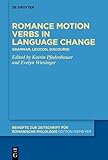Romance motion verbs in language change : Grammar, lexicon, discourse / ed. by Katrin Pfadenhauer, Evelyn Wiesinger.
Material type: TextSeries: Beihefte zur Zeitschrift für romanische Philologie ; 487Publisher: Berlin ; Boston : De Gruyter, [2024]Copyright date: 2024Description: 1 online resource (VI, 350 p.)Content type:
TextSeries: Beihefte zur Zeitschrift für romanische Philologie ; 487Publisher: Berlin ; Boston : De Gruyter, [2024]Copyright date: 2024Description: 1 online resource (VI, 350 p.)Content type: - 9783111247403
- 9783111248998
- 9783111248141
- online - DeGruyter
- Issued also in print.
| Item type | Current library | Call number | URL | Status | Notes | Barcode | |
|---|---|---|---|---|---|---|---|
 eBook
eBook
|
Biblioteca "Angelicum" Pont. Univ. S.Tommaso d'Aquino Nuvola online | online - DeGruyter (Browse shelf(Opens below)) | Online access | Not for loan (Accesso limitato) | Accesso per gli utenti autorizzati / Access for authorized users | (dgr)9783111248141 |
Frontmatter -- Contents -- Romance motion verbs in language change: New approaches and challenges -- Motion verbs in Romanian: Language contact and language renewal -- Where can we go with [aller/alé ‘go’ + verb] in hexagonal French, French spoken in Gabon and Guianese French Creole? -- A diachronic corpus study on the productivity of the French verb-serializing analytic [motion verb + main verb] pattern -- The French aller + infinitive construction in instructive discourses: New insights from video cooking shows -- “Andiamo a utilizzare il futuro analitico”: On the use of an unused form -- Pragmatic profile of a marginalised verbal periphrasis: Functional insights in the use of the Italian verbal periphrasis andare a + infinito in political discourses -- Semantic bleaching as an indicator of degrees of periphrasticity: An experimental approach -- The category of throw verbs as productive source of the Spanish inchoative construction -- (Anti-)Grammaticalization paths of Spanish venir ‘to come’ + past participle -- Venir + participle in Spanish: Semantic bleaching or meaning elaboration? -- Va y dice & Co.: Motion verbs as quotatives -- Going to surprise: The grammaticalization of itive as mirative -- Index
restricted access online access with authorization star
http://purl.org/coar/access_right/c_16ec
Cross-linguistically, motion verbs are frequently involved in language change and feature a wide array of motion-related constructions. The aim of this volume is to grasp more completely the typological characteristics and the developmental potential of motion verbs and to acknowledge the formal and functional diversity of motion-related constructions in Romance languages. To this end, the contributions in this collection provide synchronic and diachronic as well as typologically oriented studies that focus on motion verbs and single- and multi-verb constructions that have received scant attention to date. These include verbal periphrases, (pseudo-/semi-)copula and pseudo-coordinated constructions in Spanish, Italian, Romanian, French and French-based Creoles. In comparison to previous research on Romance languages, the present volume also adopts a broader perspective on language change, taking into account not only grammaticalization processes but also discursive, lexical and pragmatic phenomena such as the development of discursive, "ative or mirative functions. The studies build on functional, usage-based and constructionist models of language change and rely on corpus-based as well as experimental empirical approaches.
Issued also in print.
Mode of access: Internet via World Wide Web.
In English.
Description based on online resource; title from PDF title page (publisher's Web site, viewed 20. Nov 2024)


